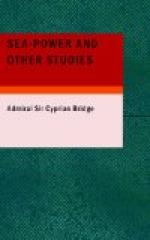The truth is that raids are far more common on land than on the ocean. For every one of the latter it would be possible to adduce several of the former. Indeed, accounts of raids are amongst the common-places of military history. There are few campaigns since the time of that smart cavalry leader Mago, the younger brother of Hannibal, in which raids on land did not occur or in which they exercised any decisive influence on the issue of hostilities. It is only the failure to see the connection between warfare on land and naval warfare that prevents these land raids being given the same significance and importance that is usually given to those carried out across the sea.
In the year 1809, the year of Wagram, Napoleon’s military influence in Central Germany was, to say the least, not at its lowest. Yet Colonel Schill, of the Prussian cavalry, with 1200 men, subsequently increased to 2000 infantry and 12 squadrons, proceeded to Wittenberg, thence to Magdeburg, and next to Stralsund, which he occupied and where he met his death in opposing an assault made by 6000 French troops. He had defied for a month all the efforts of a large army to suppress him. In the same year the Duke of Brunswick-Oels and Colonel Dornberg, notwithstanding the smallness of the force under them, by their action positively induced Napoleon, only a few weeks before Wagram, to detach the whole corps of Kellerman, 30,000 strong, which otherwise would have been called up to the support of the Grande Armee, to the region in which these enterprising raiders were operating. The mileage covered by Schill was nearly as great as that covered by the part of Hoche’s expedition which under Grouchy did reach an Irish port, though it was not landed. Instances of cavalry raids were frequent in the War of Secession in America. The Federal Colonel B. H. Grierson, of the 6th Illinois Cavalry, with another Illinois and an Iowa cavalry regiment, in April 1863 made a raid which lasted sixteen days, and in which he covered 600 miles of hostile country, finally reaching Baton Rouge, where a friendly force was stationed. The Confederate officers, John H. Morgan, John S. Mosby, and especially N. B. Forrest, were famous for the extent and daring of their raids. Of all the leaders of important raids in the War of Secession none surpassed the great Confederate cavalry General, J. E. B. Stuart, whose riding right round the imposing Federal army is well known. Yet not one of the raids above mentioned had any effect on the main course of the war in which they occurred or on the result of the great conflict.
In the last war the case was the same. In January 1905, General Mischenko with 10,000 sabres and three batteries of artillery marched right round the flank of Marshal Oyama’s great Japanese army, and occupied Niu-chwang—not the treaty port so-called, but a place not very far from it. For several days he was unmolested, and in about a week he got back to his friends with a loss which




